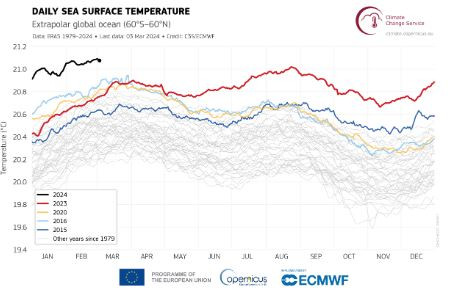February 2024 recorded a temperature about 1.77C warmer than ‘pre-industrial’ times
Last month was the warmest February since the “pre-industrial” era, according to the EU’s Copernicus Climate Change Agency.
Every month since June 2023 now records a temperature record for the corresponding time of year.
The sea surface temperature is the highest on record, while Antarctic ice has again reached extremely low levels.
Temperatures are still rising from the El Niño weather phenomenon in the Pacific, but human-caused climate change remains by far the main cause of the rise in temperatures.
“Heat-trapping greenhouse gases are undoubtedly the main culprit,” says Professor Celeste Saulo, Secretary-General of the World Meteorological Organization.
Carbon dioxide concentrations are at their highest level in at least two million years, according to the UN’s climate agency, and are on a record rise again.
Greenhouse gases have resulted in record February 2024 about 1.77 C warmer than “pre-industrial” times before people start burning large amounts of fossil fuels – according to the EU’s Copernicus Climate Change Agency.
The new record breaks the previous record, from 2016, by about 0.12C.
High temperatures hit western Australia, south-east Asia, southern Africa and South America.
Recent records are not just limited to air temperatures. Countless climate measurements are well above levels seen in modern times.
One of the most notable metrics is sea surface temperatures which have been hitting record highs in recent months.
The researchers are keen to stress that the scale and extent of the ocean warming is not simply a consequence of the natural weather phenomenon known as El Niño.
“Ocean surface temperatures in the equatorial Pacific clearly reflect El Niño. But sea surface temperatures elsewhere on the planet have been persistently and unusually high over the past 10 months,” the researchers explain.
Source: Skai
I have worked as a journalist for over 10 years, and my work has been featured on many different news websites. I am also an author, and my work has been published in several books. I specialize in opinion writing, and I often write about current events and controversial topics. I am a very well-rounded writer, and I have a lot of experience in different areas of journalism. I am a very hard worker, and I am always willing to put in the extra effort to get the job done.











